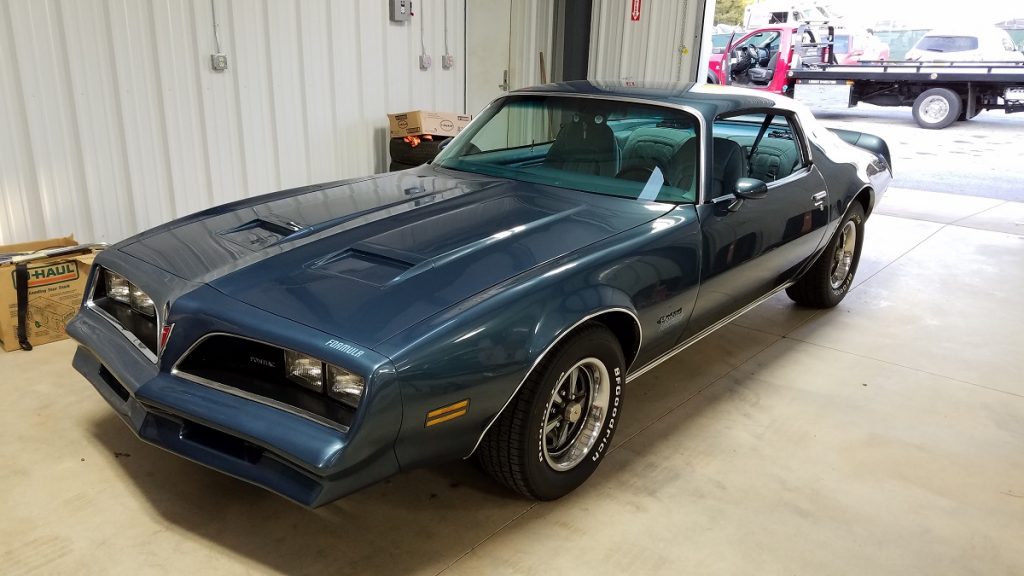
In 1977, 18-year-old Jim Elick needed a car for his first shore duty with the U.S. Navy.
Inspired by the recent release of “Smokey and the Bandit” and the flashy gold and black Pontiac Firebird Trans Am cruising across the big screen, the Indianapolis, IN native headed to Don Sisk Pontiac with his dad to try his luck securing his own getaway car.
“I kind of knew what I wanted, but could never afford a $5,000 car at 18-years-old,” Elick said. “With my motocross bike to trade and $300 in hand, I somehow landed a Nautilus Blue Firebird Formula for $98 dollars a month, and off to California I went.”
His dad co-signed for the deal with neither of them knowing just how significant the car would become.
“I bought the 1977 Formula with all the Trans Am equipment—no birds, no stickers, no fluff, no snap-on plastic air dams—just a straight, raw, very rare Firebird,” Elick said.
Affectionately nicknamed “Blue Goose,” the Formula proved a pricey ride for the novice sailor. Elick spent all but a few dollars of his military stipend on the monthly payment, gas, and insurance.
“So many times I wanted to just sell it. If I did, I would have been one of the ones that approach me at shows today, just to exclaim, I had one of those,” Elick said.
He ran the Formula ragged, speeding over sand dunes and going airborne over uneven railroad tracks with his Navy and college buddies.
“There were times I had no idea how I got home, it was almost like she had autopilot,” Elick said.
The car accompanied him on every adventure, even serving as the “escape vehicle” at his wedding, he said.
Elick returned home in 1980, working for ATA, Delta Air Lines, UPS Air, Gulfstream Aerospace, and later the FAA, while the car sat idle.
“I literally threw a blanket over the car for the next 35 years. I towed Blue Goose from garage to garage, starting her only occasionally to pressurize the lubrication system,” he said.
Then five years ago, Elick and his wife Sabrina, made the decision to “restore-the-roar” and get the road-worthy car into show-ready condition.
“She was already in great shape, mind you—with matching numbers, no corrosion, and an abundance of factory equipment installed,” Elick said.
Not bad for a model prone to rust and corrosion.
Then came the wins—so many wins that Elick sought out larger shows to even the playing field.
“After quite humbly winning so many local car shows and watching people’s reactions, you can imagine my confusion—because this Pontiac was so familiar to me I never thought of it as anything but normal,” Elick says with a grin.
Confused, but enjoying the growing list of victories, Elick decided to up the stakes.
He entered the GM F-Body Southern Regional against 200 competitors and won “Best Bird.”
At the Trans Am Dayton Nationals the Blue Goose placed second in its class (five modifications or less) against 490 Firebirds—385 of them Trans Ams. It was an exciting win, but the bigger thrill of Dayton was a chance meeting with the original General Motors engineers who developed the Pontiac Formula in the 1970s—Herb Adams, John Schinella, and Bill Davis.
Schinella, Adams, and Davis were the Chief Engineers of Product Development and Design on Project Firebird/Trans Am at General Motors in the late-1960s, and it was Schinella that fought GM to get Nautilus Blue approved and onto the assembly line.
The color was nixed before production began, but a few Formulas snuck through unnoticed—one of them Elick’s Blue Goose.
“[Schinella] actually sought us out after spotting the vehicle on the show field, recalling the negotiations for this type of paint (29L – Nautilus Blue), and the prototype interior seating intended for the Sky Bird introduced six months later,” Elick said. “The paint was cancelled just after production began in 1977, but the Blue Goose somehow slipped through—just the way she always has.”
“They all agreed it was probably one of no more than six existing VIN numbers and cowl plates. Who knew that at 18-years old?!” Elick said.
Elick had them sign his trunk lid and walked them through the modifications—all done to preserve and restore the car’s authenticity. He and his team of enthusiasts rebuilt the car, focusing on the important stuff.
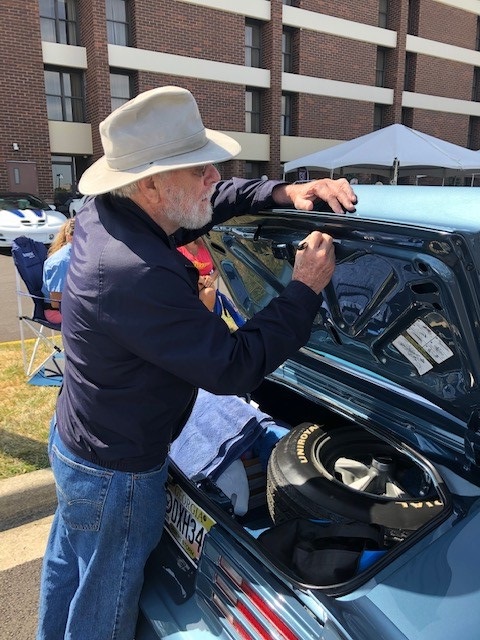
“I did build the motor a little bit. It will outperform anything stock from back then. It has a 400 in it with a low harmonic rumble that’s almost like ‘I dare ya,'” Elick said.
“We did a lot of work to it post-resto, like the door hinges and stuff, and in the process found several factory quality control escapes. Camaros and Firebirds are notorious for very heavy doors, so the hinges started to lag real bad,” he said. “We pulled them off and we reworked both of them. When we took the doors off the chassis it was metal to metal. GM pushed this car out so fast they didn’t even corrosion-proof or paint the mating surfaces for the hinge to body—it was just bare metal.”
He also updated the one-speaker sound system with AM/FM radio and an 8-track player—which he still has—for a more modern configuration, making some additional discoveries.
“When I pulled out the factory deck in the back to put the new sound in—I see this black goo. It looks just like bubble gum on the street that people have been walking over. Just flat, black, and gooey,” Elick said.
Luckily his buddy knew the origin, and it also signified rushed production of the vehicle.
“I’m working with this guy that really knows Pontiac, and he says, ‘When your car was going down the production line in Ohio, the whistle for a ten-minute break for the line workers must have gone off right when they were sealing the rear window with sealant guns. They laid the guns on the deck and sealant dripped from the nozzle to the car. When they came back they just sealed right over it, never cleaned it up,’” Elick said.
And the incongruities don’t stop there.
According to Elick, the front end doesn’t fit.
“This was the first Pontiac production car ever in history to offer square headlights. To accommodate those, they made a Endura bumper for the front end but it doesn’t fit the metal doghouses of the car, it just doesn’t,” he said.
Flaws to some, but flaws that judges go wild for, Elick said.
“Any good judge worth his weight will tell you to leave it alone. Leave that alone, leave the dashboard that’s pulling out alone—do not repair them. The car shows much better unrepaired—it proves the originality. One judge even told him, “We knew certain aspects of these cars were junk in the mid-1970s—to have one that looks like yours now is even more astonishing. It has all the symptoms of those bad qualities from back then, but you’ve left them in there and it proves originality.”
Elick finished restoring the 1977 Pontiac Firebird Formula 400 in November of 2016.
Still new to the show arena, but more than able to hold its own, Elick’s Formula 400 is the recipient of over two dozen awards and trophies, with six Best of Shows earned.
Special thanks to:
In special honor of Elick’s father, who passed away a few years after helping his son purchase the Formula. He is a man much missed and the reason for Elick’s ongoing reluctance to part with the car. Additional thanks to Sabrina Elick, Brian Trevena, Brian’s Paint & Body Shop staff, Jodie, Johnny, Chris, and Tim and Scottie at Coweta Car Care.
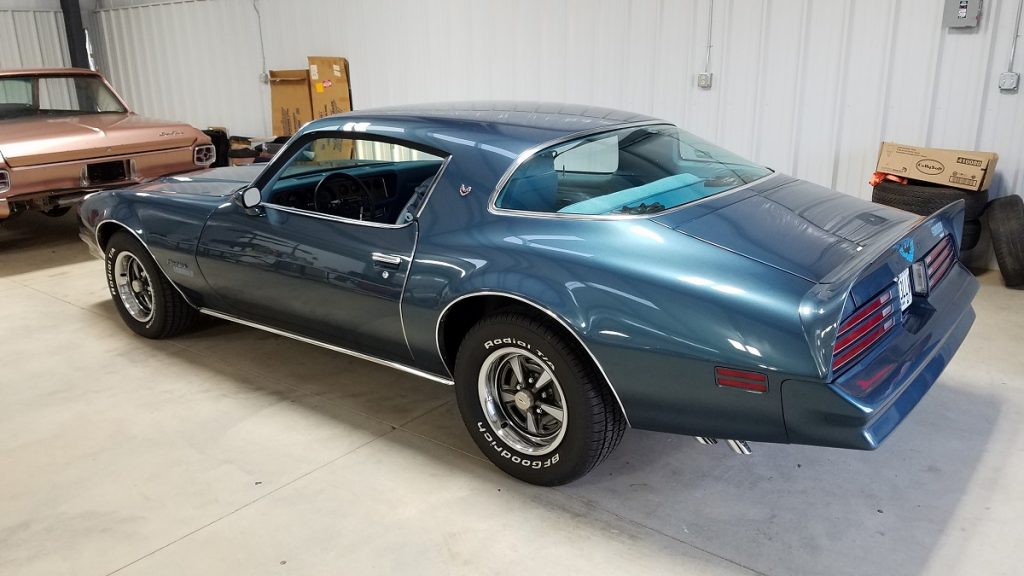
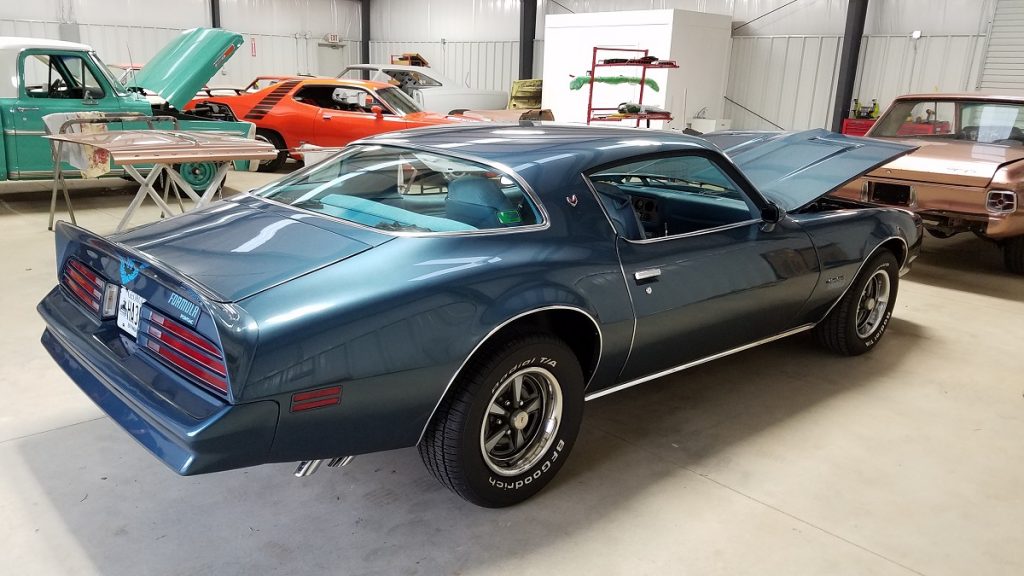
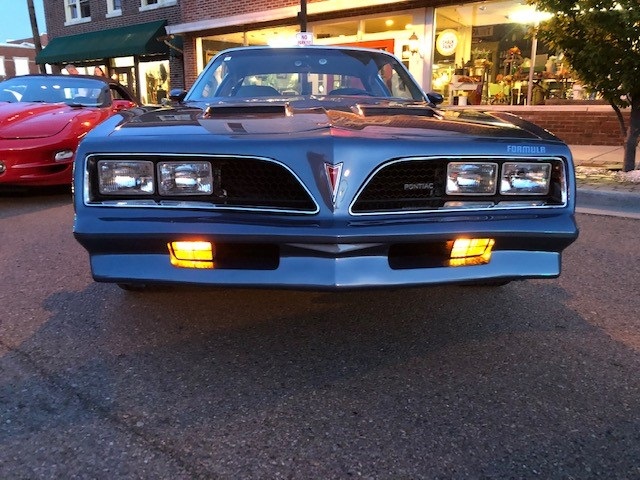

Have a similar story at the same age and a 77 Silver Formula 400 4sd.
I had a 1977 Formula Silver and Black. Mine had a rear seat console. A special order option and it always got in the way.
I am living in France and have exactly the same Formula, nautilus blue and full option.
My 77 just burn up in fire. Trying to find another with Nautilus blue. Help
I have a roller 77 Nautilus Blue formula if you are looking to build one. $4,500.
I have a 77 formula,long story my first car was a 78 305 firebird,this formula came with pontiac engine with 4 speed,i need a few things,but its in damn good shape,had it for 30 years give or take.i have 6x heads and intake.need the 400 block and trans,peddles are still in the car,for the stick shift,my front end on the formula is my blue one from my 1st 78,and trunk lid.its a part of me for sure.your car popped up on my phone,and i couldn’t believe it.
had a 77 back in the day – loved it – am working on finding one now – absolutely going to consider this color – it is amazing –
I had a 77 formula but the paint was aqua marine blue! I bought it in northern Canada and was the best vehicle I ever had. I did tear it up a bit and a dump truck ran into the back end crumpling the truck up to the rear window. I wonder where it is now!
Great story. I have an opportunity to buy a 77 similar to yours that has been completely restored and am trying to get educated. If you have time to give me a call or some key questions to ask I’d much appreciate it. I’m in KS and curious where you’re located.
Thanks so much
Steve
620.474.3909
Beautiful Formula. I had a 78 Formula that was a dark green metallic with white deluxe seats headliner and door panels with black dashboard, carpet and console. At the time I didn’t realize what a rare color combo it was! The formula lettering was a lighter green! Wish I still had that one!! I now have a 27000 original mile 79 Nocturne Blue T/A with deluxe light blue hobnail seats and it has the WS7 special handling package. My rarest Formula was a 79 W72 Ws6 400 4 sod.
I have 77 Formula Nautilus Blue 400 4spd car. But not original motor. Delux light blue interior just like car in this article. I first thought when i seen the pics it was mine.
Ok I have a 77 formula with the 29L an 29UP code but I have the standard interior which is white . Is there away the wrong abt type of interior that came with this color I am 3rd owner of a 73000 mile original car an second owner bought it in 78 would really like to know more on this color or if this article is correct .or if I could have 1 of 7 in this color
I ordered one just like photos in Waycross ga great car
I loved my /77 Firebird Formula that I had looked for an F-Body style that I liked and could afford for over a year. One Saturday morning, I stopped in at Carter GM in Burnaby, BC and saw this exact same car. The Dealer rep and I took it to my house in North Vancouver to show my parents and they approved whole heartedly about buying this car!!! I drove it for quite a few years and when my husband and I got married, as he was my mechanic, he said that he wanted a Camaro, instead of a Firebird. After 3 kids and a few more years, we ended up selling it to buy a (ugh) station wagon!!!
He put a 403 engine in it and we painted it two tone maroon with gold pin stripping. It turned a lot of heads, for sure!!!
I had been into town one day and saw my Firebird and went home crying ’cause I missed that car so much!!! It was MY car and I was upset that he had talked me into selling it. But three kids in the back was not comfortable!!! We had purchased a full size Jimmy and my husband said we did not need two full size vehicles so I could go looking for another one but it had to be a Camaro! I now have a silver /81 Camaro, full load. It’s a beautiful car but my heart is still with my /77, sigh!!!
Ok. How many of the 6 do they know of I think I have 1
I owned the same 77 formula in this color in the late 70’s. Mine was an auto with a 350. It also had the wide lighter blue stripe that ran down the side from the front and wrapped over the roof.
As far as I understand there were only 6 Formula’s produced with the nautilus blue code 29L in 1977. Living in France I must be probably the sole owner of one of these nautilus blue Formula. How much extra value doest it correspond ?
I have a 1977 Esprit (Ponac 350 4 bbl) in code 29 Nautilus Blue with Parchment interior and Parchment Vinyl Top. Never understood why I never saw any in this color until I ran across this article.